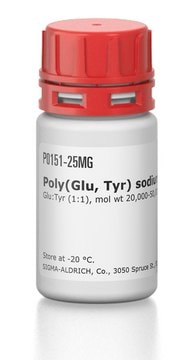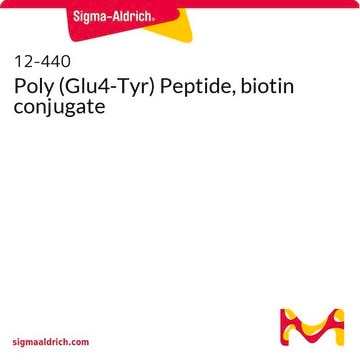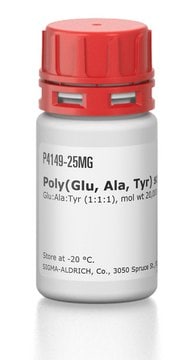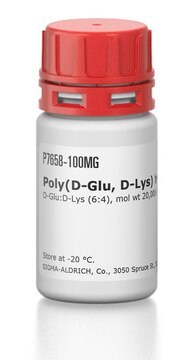81357
Poly(Glu, Tyr) sodium salt
suitable for ligand binding assays, Mol wt 20,000-50,000
Sign Into View Organizational & Contract Pricing
All Photos(1)
About This Item
Recommended Products
product name
Poly(Glu, Tyr) sodium salt, mol wt 20,000-50,000, Glu:Tyr 4:1
Quality Level
form
powder
feed ratio
Glu:Tyr (4:1)
mol wt
20,000-50,000
technique(s)
ligand binding assay: suitable
color
white to off-white
storage temp.
−20°C
Looking for similar products? Visit Product Comparison Guide
Biochem/physiol Actions
Poly(Glu,Tyr) (poly(Glu,Tyr) 4:1 random copolymer) is used as a substrate for the evaluation of protein tyrosine kinase(s).
Poly(Glu,Tyr) 4:1 is a polyamino acid used in the manufacture of electrochemical biosensors for detection of reactions such as Fenton induced tyrosine oxidation.
Other Notes
For additional technical information on polyamino acids please visit the Polyamino acid FAQ resource.
Storage Class Code
11 - Combustible Solids
WGK
WGK 3
Flash Point(F)
Not applicable
Flash Point(C)
Not applicable
Personal Protective Equipment
dust mask type N95 (US), Eyeshields, Gloves
Certificates of Analysis (COA)
Search for Certificates of Analysis (COA) by entering the products Lot/Batch Number. Lot and Batch Numbers can be found on a product’s label following the words ‘Lot’ or ‘Batch’.
Already Own This Product?
Find documentation for the products that you have recently purchased in the Document Library.
Morten R Clausen et al.
Journal of agricultural and food chemistry, 56(18), 8692-8698 (2008-09-02)
Oxidation of 2,2'-azino-bis(3-ethylbenzthiazoline-6-sulfonic acid) by lactoperoxidase was found to be inhibited by tyrosine-containing random amino acid copolymers but not by tyrosine. Both electrostatic effects and polymer size were found to be important by comparison of negatively and positively charged copolymers
Masanobu Chiku et al.
Biosensors & bioelectronics, 26(1), 235-240 (2010-07-17)
In this report, we determined protein tyrosine kinase (PTKs) activity in human epidermoid carcinoma cells (A431) by employing a novel electrochemical method using boron-doped diamond (BDD) electrodes that enables the electrochemical oxidation of tyrosine (Tyr), phosphorylated Tyr (Tyr-P) and sulfated
J Shao et al.
Diabetes, 49(4), 603-610 (2000-06-28)
The cellular mechanisms for the insulin resistance of pregnancy and gestational diabetes mellitus (GDM) are unknown. The membrane protein plasma cell membrane glycoprotein-1 (PC-1) has been identified as an inhibitor of insulin receptor tyrosine kinase (IRTK) activity. We investigated insulin
Na Qu et al.
Biosensors & bioelectronics, 26(5), 2292-2296 (2010-11-03)
A simple and sensitive electrochemical biosensor was used to detect tyrosine oxidation induced by hydroxyl radicals generated by Fenton reaction (Fe(2+)/H(2)O(2)). Poly(glu, tyr) (4:1) peptides were immobilized on indium tin oxide (ITO) electrode surface via layer-by-layer assembly technique, and Os(bpy)(3)(2+)-mediated
D M Williams et al.
The Journal of biological chemistry, 275(49), 38127-38130 (2000-09-28)
Protein-tyrosine kinases contain a catalytic loop Arg residue located either two or four positions downstream of a highly conserved Asp residue. In this study, the role of this Arg (Arg-318) in the protein-tyrosine kinase C-terminal Src kinase (Csk) was investigated.
Our team of scientists has experience in all areas of research including Life Science, Material Science, Chemical Synthesis, Chromatography, Analytical and many others.
Contact Technical Service








